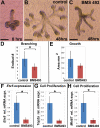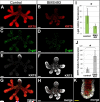Retinoic acid signaling regulates Krt5 and Krt14 independently of stem cell markers in submandibular salivary gland epithelium
- PMID: 27884045
- PMCID: PMC5348080
- DOI: 10.1002/dvdy.24476
Retinoic acid signaling regulates Krt5 and Krt14 independently of stem cell markers in submandibular salivary gland epithelium
Abstract
Background: Retinoic acid (RA), the active metabolite of vitamin A, has been demonstrated to be important for growth and branching morphogenesis of mammalian embryonic salivary gland epithelium. However, it is not known whether RA functions directly within epithelial cells or in associated tissues that influence morphogenesis of salivary epithelium. Moreover, downstream targets of RA regulation have not been identified.
Results: Here, we show that canonical RA signaling occurs in multiple tissues of embryonic mouse salivary glands, including epithelium, associated parasympathetic ganglion neurons, and nonneuronal mesenchyme. By culturing epithelium explants in isolation from other tissues, we demonstrate that RA influences epithelium morphogenesis by direct action in that tissue. Moreover, we demonstrate that inhibition of RA signaling represses cell proliferation and expression of FGF10 signaling targets, and upregulates expression of basal epithelial keratins Krt5 and Krt14. Importantly, we show that the stem cell gene Kit is regulated inversely from Krt5/Krt14 by RA signaling.
Conclusions: RA regulates Krt5 and Krt14 expression independently of stem cell character in developing salivary epithelium. RA, or chemical inhibitors of RA signaling, could potentially be used for modulating growth and differentiation of epithelial stem cells for the purpose of re-populating damaged glands or generating bioengineered organs. Developmental Dynamics 246:135-147, 2017. © 2016 Wiley Periodicals, Inc.
Keywords: KRT5; keratin; progenitor; retinoid; stem cell; vitamin A.
© 2016 Wiley Periodicals, Inc.
Figures






Similar articles
-
Retinoic acid regulates embryonic development of mammalian submandibular salivary glands.Dev Biol. 2015 Nov 1;407(1):57-67. doi: 10.1016/j.ydbio.2015.08.008. Epub 2015 Aug 13. Dev Biol. 2015. PMID: 26278034 Free PMC article.
-
Endothelial cell regulation of salivary gland epithelial patterning.Development. 2017 Jan 15;144(2):211-220. doi: 10.1242/dev.142497. Development. 2017. PMID: 28096213 Free PMC article.
-
RDH10-mediated retinol metabolism and RARα-mediated retinoic acid signaling are required for submandibular salivary gland initiation.Development. 2018 Aug 2;145(15):dev164822. doi: 10.1242/dev.164822. Development. 2018. PMID: 29986869 Free PMC article.
-
Regulatory Mechanisms Driving Salivary Gland Organogenesis.Curr Top Dev Biol. 2015;115:111-30. doi: 10.1016/bs.ctdb.2015.07.029. Epub 2015 Oct 21. Curr Top Dev Biol. 2015. PMID: 26589923 Free PMC article. Review.
-
Epithelial stem/progenitor cells in the embryonic mouse submandibular gland.Front Oral Biol. 2010;14:90-106. doi: 10.1159/000313709. Epub 2010 Apr 20. Front Oral Biol. 2010. PMID: 20428013 Free PMC article. Review.
Cited by
-
Nigella sativa oil mitigates xerostomia and preserves salivary function in radiotherapy-treated mice.Laryngoscope Investig Otolaryngol. 2023 Jul 25;8(4):912-920. doi: 10.1002/lio2.1122. eCollection 2023 Aug. Laryngoscope Investig Otolaryngol. 2023. PMID: 37621284 Free PMC article.
-
Senescent cells and macrophages: key players for regeneration?Open Biol. 2020 Dec;10(12):200309. doi: 10.1098/rsob.200309. Epub 2020 Dec 23. Open Biol. 2020. PMID: 33352064 Free PMC article. Review.
-
Retinoic Acid Signal Negatively Regulates Osteo/Odontogenic Differentiation of Dental Pulp Stem Cells.Stem Cells Int. 2020 Jun 27;2020:5891783. doi: 10.1155/2020/5891783. eCollection 2020. Stem Cells Int. 2020. PMID: 32676119 Free PMC article.
-
Retinoic acid signaling maintains epithelial and mesenchymal progenitors in the developing mouse ureter.Sci Rep. 2017 Nov 1;7(1):14803. doi: 10.1038/s41598-017-14790-2. Sci Rep. 2017. PMID: 29093497 Free PMC article.
-
A highly resolved integrated single-cell atlas of HPV-negative head and neck cancer.bioRxiv [Preprint]. 2025 Mar 4:2025.03.02.640812. doi: 10.1101/2025.03.02.640812. bioRxiv. 2025. PMID: 40093171 Free PMC article. Preprint.
References
-
- Broudy VC. Stem cell factor and hematopoiesis. Blood. 1997;90:1345–1364. - PubMed
MeSH terms
Substances
Grants and funding
LinkOut - more resources
Full Text Sources
Other Literature Sources
Research Materials
Miscellaneous

